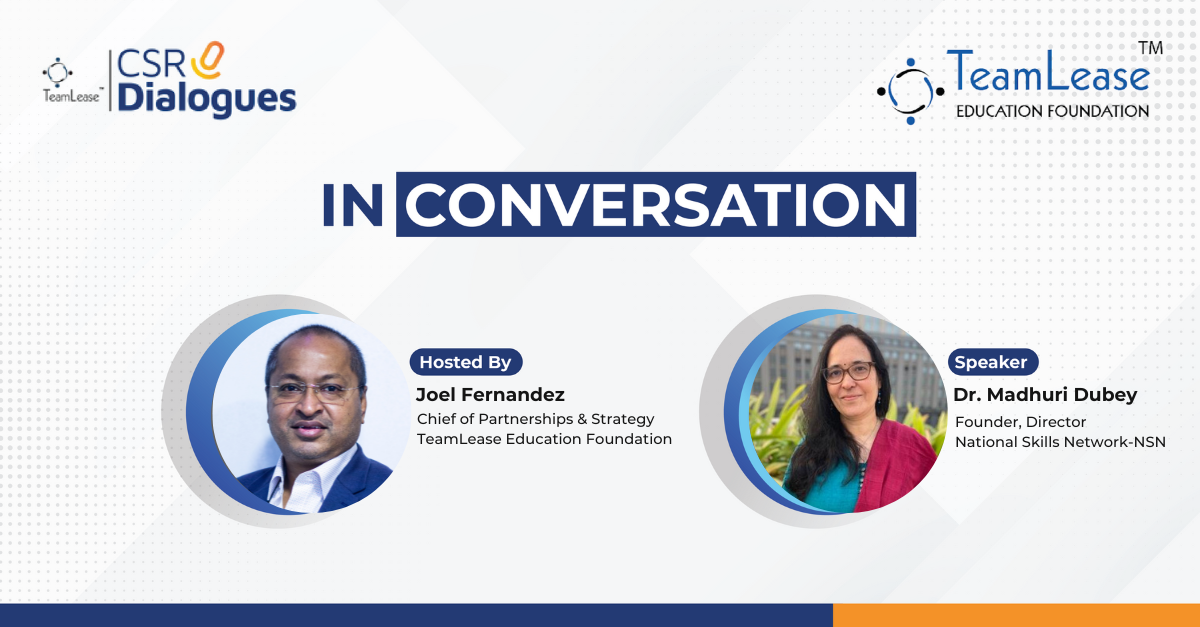In a recent edition of the CSR Dialogues, Dr. Madhuri Dubey – Founder, Director - National Skills Network (NSN) spoke extensively with Joel Fernandez, Chief of Partnerships & Strategy, TeamLease Education Foundation on the positive impact of skilling and vocational training in bridging the gap between what industry needs and the shortfalls in formal education.
The NSN is a digital platform that works towards connecting the 5Es – economy, education, employability, employment and entrepreneurship. And, it has emerged as a powerful tool to support advocacy and communication in India's skill development and work-integrated ecosystem. The conversation was wide-ranging covering numerous topics.
While brainstorming on how to promote technology proficiency and digital literacy among young people in underserved communities, Dr Dubey offered many key insights. She highlighted the different challenges that youth face in urban and rural areas. In cities, even the poor are willing to invest in good quality smartphones, primarily because urban centers offer universal connectivity. So with smartphones, even poor youngsters can plug into opportunities like becoming delivery personnel, or drivers for large cab platforms - so these youth became digitally empowered because of equal access enabled by wide connectivity.
 Dr Dubey also highlighted learnings gleaned during the COVID period, for instance, where the critical aspect of access allowed school work to continue during lockdowns. But while this seemed like ‘no child was getting left behind’ - in reality, students from poorer backgrounds were at a disadvantage, particularly when such families would have only a single device being shared my many members - and if the device enabled the bread-winner of the family to keep his or her job, then school-work would not be a priority.
Dr Dubey also highlighted learnings gleaned during the COVID period, for instance, where the critical aspect of access allowed school work to continue during lockdowns. But while this seemed like ‘no child was getting left behind’ - in reality, students from poorer backgrounds were at a disadvantage, particularly when such families would have only a single device being shared my many members - and if the device enabled the bread-winner of the family to keep his or her job, then school-work would not be a priority.
In such cases, ‘engagement’ becomes the challenge - how to keep the target audience of young school kids engaged during lockdowns, given the challenges associated with the absence of laptops and sharing one mobile phone between multiple generations. Joel Fernandez highlighted the fact that many ed tech companies were gamifying learning content to drive up engagement levels.
This is where Dr Dubey sees scope for CSR intervention, whereby corporates can connect with mobile phone companies, for instance to subsidize high-speed connections/ data services or make high-end, education-enabling first-hand smart devices available to under-served communities.
To learn more about bridging the digital divide for the youth, watch HERE
 The topic shifted to the steps that need to be adopted to popularize apprenticeship embedded certificates/ diplomas. The consensus was that though apprenticeships were slowly gaining popularity, the pace was too slow and there was much room for improvement. Dr Dubey felt the biggest hurdle to be tackled was the lack of awareness about what good apprenticeship-linked diplomas/degrees offered. And that the emphasis needed to be on how this differed from typical internships.
The topic shifted to the steps that need to be adopted to popularize apprenticeship embedded certificates/ diplomas. The consensus was that though apprenticeships were slowly gaining popularity, the pace was too slow and there was much room for improvement. Dr Dubey felt the biggest hurdle to be tackled was the lack of awareness about what good apprenticeship-linked diplomas/degrees offered. And that the emphasis needed to be on how this differed from typical internships.
Once the stakeholders - both parents and the youth - were adequately educated about the benefits of apprenticeship-linked certificates, they would be in a position to take informed decisions about a youngster’s future. Being better informed also helps overcome the public’s blind preference for ANY degree, however unemployable the course leaves the graduate and it builds awareness about stipends that apprentices earn. These apprenticeships also offered training in fields beyond just the manufacturing shopfloor but include the hospitality and retail sectors, among others.
Unfortunately, ‘apprenticeships’ are perceived as ‘blue collar’ and hence Dr Dubey suggested that overcoming the stigma attached to working with one’s hands was important. And this could be done by highlighting case studies of leading industrialists who embraced opportunities to get their hands dirty, on shopfloors, as youngsters.
Learn more about how to promote apprenticeship-linked-certification HERE.
 Dr Dubey and Joel Fernandez then discussed whether with all the data now available about sectors where skills shortage was rampant and unemployment figures across states, could AI somehow solve the problems.
Dr Dubey and Joel Fernandez then discussed whether with all the data now available about sectors where skills shortage was rampant and unemployment figures across states, could AI somehow solve the problems.
The discussion moved to how with widespread technology adoption, most organizations now had the capability for predicting, analyzing & forecasting demand. So AI had the potential to operate as another layer on top, an intelligent player or the smart layer, to collect all the data from different sources, then analyze it and come up with indicators on which industries would require what kind of talent down the line. This would enable skilling organizations or degree-linked apprenticeships to plan curriculum, well ahead and have job-ready graduates available. In short, AI could bring about some dynamism in the skilling/apprenticeship space.
AI-induced agility in skilling could help build a resilient workforce for emerging sectors like EV manufacturing, renewal/green energy, logistics, etc.
To learn more about how AI could bridge India’s skilling gap, watch HERE
 Another question addressed in this CSR Dialogue was how to expand and improve vocational training/ education in order to empower Indian youth.
Another question addressed in this CSR Dialogue was how to expand and improve vocational training/ education in order to empower Indian youth.
While the discussion did cover the advocacy moves from the government, the game-changer is expected to be the new National Education Policy, that gives vocational training a lot of impetus, by connecting education to the economy, instead of the two sectors operating in silos.
With Dr Dubey’s educational background being in public policy, she did caution that building up the case for apprenticeships needed to be done on a war footing. If there weren’t immediate changes in mindsets, the NEP’s recommendations wouldn’t have any impact in the short term, i.e., sectors facing skills shortage could continue operating in a sub-optimal manner for years. So Dr Dubey’s suggestion was for tackling the bias against apprenticeships at the early school levels itself.
Such a shift in mindsets, would also lay the ground for increased entrepreneurship. This long-term view of addressing the overcall problems plaguing the skilling ecosystem, also opened up opportunities for companies to tie up closely with education institutions to build up the job-ready workforce they require.
To learn more about improving the prospects for those turning to vocational training, watch HERE
 This enlightening discussion ended on developing accurate metrics to measure the true impact of the many youth focused initiatives happening across the country, driven by the government.
This enlightening discussion ended on developing accurate metrics to measure the true impact of the many youth focused initiatives happening across the country, driven by the government.
Dr Dubey’s take was that there are two or three important parameters to be tracked - one was placement, the other could be the attrition rate after the first placement; and the third could be how aligned the placement was to the candidates own aspirations - because it is a combination of all three that ensured long-term employment at the same organization - benefiting both, employer, employee and the economy.
Other parameters/metrics discussed included how forced migration might be affecting these youth programs, and whether other interventions could be designed to address the issues thrown up. Dr Dubey also linked forced breaks in employment to the typical experiences of women in the workforce - being forced to leave because of marriage in another city, during child birth, etc. Measuring various parameters, enabled policy makers and HR heads to design vocational and hiring programs that address the problems employees face.
To learn more about measuring metrics to improve employee retention, watch HERE.





